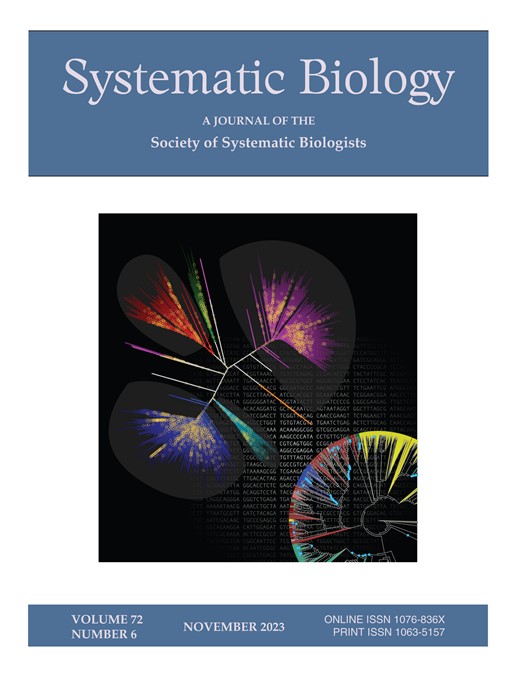研究同源基因树冲突和解释趋同性状进化的新工具
IF 6.1
1区 生物学
Q1 EVOLUTIONARY BIOLOGY
引用次数: 0
摘要
在整个生命树中发现了表型趋同,而远亲物种的形态相似性通常被认为是独立进化的。然而,澄清特征的起源最近突出了进化的复杂性,因为明显的趋同特征通常具有相似的遗传基础。因此,构成这些特征的基因的树状拓扑结构经常与物种关系的整体历史相冲突。这种冲突通常是由不完整的谱系分选、基因渗入或水平基因转移造成的,这对系统学家来说既是一个挑战,也是一个令人兴奋的机会,可以研究将分子轨迹与性状进化联系起来的丰富而复杂的信息网络。在这里,我们提出了一个新的冲突识别程序,名为CAnDI(冲突和重复标识符),它可以分析同源基因树中的冲突,而不是推断的同源基因。我们证明,在真核生物生命之树的六个数据集中,使用CAnDI分析同源树中的冲突比同源树产生更多的比较。以有魅力的开花植物群石竹属(Caryophyllales)的肉食性陷阱为例,我们证明了分析整个同源树上的冲突有助于推断直立遗传变异对性状进化的贡献:通过解剖同源树上的所有基因关系,我们发现基因组证据表明,多形粘液粘陷阱的分子基础可能存在于所有肉食性石竹属(Caryophyllales)的祖先中。我们还发现,许多基因的进化轨迹将具有相似陷阱装置的物种分类为有助于植物食肉性的蛋白质,并确定了一个侧边器官边界域转录因子作为调节粘性陷阱发育的可能候选基因。本文章由计算机程序翻译,如有差异,请以英文原文为准。
CAnDI: a new tool to investigate conflict in homologous gene trees and explain convergent trait evolution
Phenotypic convergence is found across the tree of life, and morphological similarities in distantly related species are often presumed to have evolved independently. However, clarifying the origins of traits has recently highlighted the complex nature of evolution, as apparent convergent features often share similar genetic foundations. Hence, the tree topology of genes that underlie such traits frequently conflicts with the overall history of species relationships. This conflict, which usually results from incomplete lineage sorting, introgression or horizontal gene transfer, creates both a challenge for systematists and an exciting opportunity to investigate the rich, complex network of information that connects molecular trajectories with trait evolution. Here we present a novel conflict identification program named CAnDI (Conflict And Duplication Identifier), which enables the analysis of conflict in homologous gene trees rather than inferred orthologs. We demonstrate that the analysis of conflicts in homologous trees using CAnDI yields more comparisons than in ortholog trees in six datasets from across the eukaryotic tree of life. Using the carnivorous trap of Caryophyllales, a charismatic group of flowering plants, as a case study we demonstrate that analysing conflict on entire homolog trees can aid in inferring the contribution of standing genetic variation to trait evolution: by dissecting all gene relationships within homolog trees, we find genomic evidence that the molecular basis of the pleisiomorphic mucilaginous sticky trap was likely present in the ancestor of all carnivorous Caryophyllales. We also show that many genes whose evolutionary trajectories group species with similar trap devices code for proteins contributing to plant carnivory and identify a LATERAL ORGAN BOUNDARY DOMAIN transcription factor as a possible candidate for regulating sticky trap development.
求助全文
通过发布文献求助,成功后即可免费获取论文全文。
去求助
来源期刊

Systematic Biology
生物-进化生物学
CiteScore
13.00
自引率
7.70%
发文量
70
审稿时长
6-12 weeks
期刊介绍:
Systematic Biology is the bimonthly journal of the Society of Systematic Biologists. Papers for the journal are original contributions to the theory, principles, and methods of systematics as well as phylogeny, evolution, morphology, biogeography, paleontology, genetics, and the classification of all living things. A Points of View section offers a forum for discussion, while book reviews and announcements of general interest are also featured.
 求助内容:
求助内容: 应助结果提醒方式:
应助结果提醒方式:


